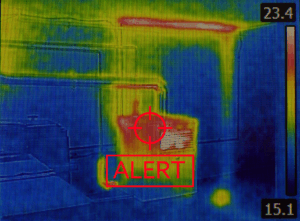In industrial environments like mines, food processing plants, and sawmills, reliable video transmission is crucial for safety, surveillance, and operational monitoring. However, these settings often present unique challenges — tight spaces, hazardous conditions, or vast expanses of terrain — where traditional Ethernet connections are impractical or impossible.
In such cases, wireless video transmission systems offer a robust and flexible solution.
Let’s see if wireless is the right approach for your application (it’s not ideal for everyone).
Why Wireless Video Transmission is Essential in Industrial Settings
Industrial operations, whether underground in mines or across sprawling outdoor sawmills, often require real-time video feeds and remote monitoring.
When traditional wired connections are not an option due to the environment, wireless video solutions come into play.
1. Mines and Underground Facilities
In mining operations, video monitoring plays a critical role in ensuring worker safety, monitoring equipment, and surveying hazardous areas. Installing Ethernet cables in these settings is a logistical nightmare — tunnels are narrow and the surroundings can be harsh and unpredictable.
Wireless video systems allow operators to monitor underground operations in real time, without the need to run extensive cables through difficult terrain. By using wireless transmitters and receivers, you can achieve high-quality video transmission even in remote or confined spaces.
2. Food Processing Plants
Food processing plants require a high level of monitoring to ensure quality control, regulatory compliance, and workplace safety. However, these facilities often involve harsh conditions, including extreme temperatures, humidity, and constant movement.
Ethernet cables can be difficult to install in such environments due to the risk of contamination, water damage, and physical obstructions. Wireless video transmission systems overcome these challenges, offering flexibility without compromising on video quality.
Wireless systems allow for remote monitoring of production lines, equipment, and inventory, even in areas that are difficult to access with traditional wired cameras.
3. Sawmills and Lumber Yards
Sawmills and lumber yards often cover vast outdoor areas where running Ethernet cables is neither practical nor cost-effective. These sites also feature large machinery, dust, and debris, which can make wired systems more prone to wear and tear.
Wireless video systems offer a durable, flexible solution in these settings, enabling real-time monitoring of equipment, safety systems, and operations across large expanses without the limitations of cables.
Whether it’s monitoring machinery performance, tracking inventory, or ensuring worker safety, wireless systems provide the coverage needed without the complexity of extensive wiring.
4. Demolition Sites
In the high-stakes environment of demolition, real-time video monitoring ensures safety, operational efficiency, and compliance with regulations. Wireless systems allow video feeds to be transmitted reliably from areas where running cables is either too cumbersome or poses a hazard, such as atop cranes or near collapsing structures.
Demolition cranes, which often operate at significant heights and move frequently, benefit greatly from wireless video solutions. Mounting cameras on the cranes enables operators to monitor blind spots, improve precision, and ensure safe handling of debris—all without the limitations of physical wiring.
Wireless setups also reduce downtime associated with repairing or re-routing damaged cables, which can occur when working in harsh environments.
Advantages of Industrial Wireless Video Transmission
Wireless video solutions provide several advantages in industrial applications. Here’s why wireless is the right choice in certain industrial environments.
1. Flexibility and Mobility
Wireless systems provide unparalleled flexibility. In large, constantly changing environments such as sawmills or mines, the ability to move and reconfigure video equipment without worrying about cables is invaluable.
Wireless solutions can be quickly relocated to different areas of the site, allowing businesses to adjust to new operational needs without major installation challenges.
2. Reduced Installation Time and Costs
Running Ethernet cables through industrial facilities can be time-consuming and costly, especially in environments like demolition sites or oil refineries, where safety regulations and environmental factors complicate installations.
Wireless systems dramatically reduce installation time and cost by eliminating the need for extensive cabling and trenching. This leads to faster deployments and less disruption to daily operations.
3. Safety in Hazardous Environments
Industrial facilities often feature dangerous environments, from the heavy machinery in sawmills to the toxic gasses in mines or refineries. Running cables through these spaces introduces a potential risk of damage, which could lead to safety hazards or downtime.
Without trails of wires, wireless systems are less susceptible to physical damage and can be safely installed without interfering with critical machinery or workers’ movement.
4. Scalability
As industrial operations expand or evolve, the ability to scale video systems is essential. Wireless solutions make it easy to add additional cameras, transmitters, and receivers without the complexity of running new cables.
Whether you’re expanding video coverage to a new section of a mine or increasing monitoring points in a food processing plant, wireless technology allows for seamless integration and growth.
Challenges and Limitations of Wireless Video in Industrial Settings
While wireless video systems offer significant benefits, they are not for every application. Here are a few limitations of this approach:
1. Line of Sight (LOS) Requirements
Wireless video systems depend on a clear line of sight between the transmitter and receiver. In areas like mines, sawmills, or industrial plants, physical obstacles — large machinery, storage racks, and structural features — can block the signal.
For optimal performance, careful planning is required to ensure the transmitter and receiver are positioned to minimize obstructions and ensure reliable video transmission.
2. Range Limitations
Wireless systems have a maximum range, which can be affected by environmental factors. In large facilities, such as sawmills or vast mining operations, the signal may weaken over long distances or when encountering obstacles.
Selecting a wireless system with sufficient range and adding repeaters or signal boosters where necessary is essential to ensure full coverage across the site.
3. Interference from Other Devices
Wireless systems can be susceptible to interference from other electronic devices, including Wi-Fi networks, radio signals, and heavy machinery. In industrial settings, where numerous electronic devices are often operating simultaneously, interference can disrupt the video signal, leading to quality degradation or loss of transmission.
To combat this, choose wireless systems that operate on less congested frequencies and are designed to withstand interference.
4. Bandwidth and Video Quality
Industrial applications often require high-definition video for monitoring equipment, safety systems, or production lines. Wireless systems need adequate bandwidth to transmit high-quality video signals.
If the bandwidth is insufficient, video quality may suffer, leading to lag, pixelation, or loss of frames. It’s essential to choose a wireless video system that supports the required resolution and frame rates, ensuring that the video feed remains clear and reliable.
Technical Recommendations for Industrial Wireless Video
To get the most out of your wireless video system, we make sure all our installation projects for industrial clients check the following boxes:
1. Avoid Signal Interference
To minimize interference, select wireless systems that operate on cleaner, less crowded frequencies such as the 5 GHz band. Careful positioning of wireless transmitters and receivers can also reduce the risk of signal degradation due to interference from machinery or other electronics.
2. Consider Your Environmental Conditions
Industrial environments are tough on equipment, so make sure your wireless system is designed to withstand temperature extremes, humidity, dust, and vibrations.
Opticom’s rugged wireless solutions are built to perform reliably in demanding conditions, ensuring that you maintain stable video transmission even in the harshest industrial settings.
3. Plan for Power Needs
Wireless video transmitters and receivers still require power. Be sure to have reliable power sources available at the installation points, especially in remote or hazardous locations like mines or oil rigs.
For off-grid sites, consider solar-powered or battery-powered solutions to maintain operation without compromising safety.
Wireless Solutions for Industrial Applications — Final Thoughts
Wireless is not our go-to solution for industrial applications. However, there are cases when it makes sense to go wireless.
In such cases, you need to make sure that you don’t lose connectivity or video quality. This is why it’s essential to work with a video monitoring systems provider that understands the unique challenges of each industrial environment.
At Opticom, we’ve been helping industrial plant managers with tailor-made video monitoring solutions for over 50 years. We’d love to advise you on whether wireless is the right solution for you too.







